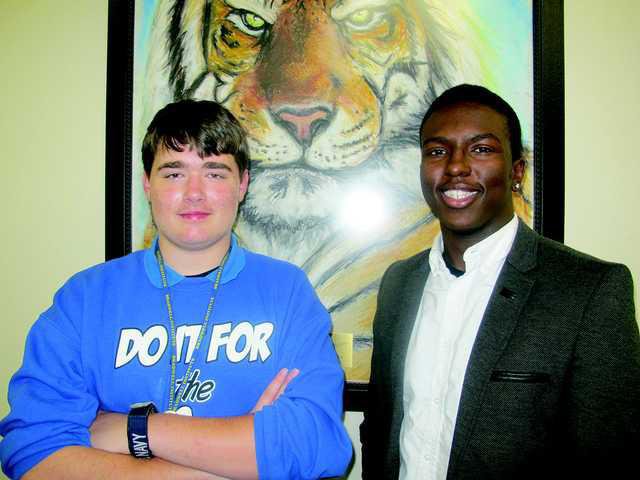Chris Schultz, a Bradwell Institute sophomore and co-leader of Student 2 Student, was one of 12 students chosen to attend the Military Child Education Coalition Frances Hesselbein Student Leadership Program in Colorado Springs, Colorado, at the United States Air Force Academy.
The coalition selected high school leaders throughout its Student 2 Student Program to attend the weeklong program, from April 3-8. Schultz was nominated by BI Counselor Krista Stewart to attend the conference, where he and 11 other students from around the world learned about leadership development, goal setting, team building and community involvement.
Student 2 Student is a student-led organization that helps students transition into high school. The group helps new students and freshmen acclimate to the school throughout the year and provides support when students move.
Bradwell’s S2S and Junior ROTC host tours at the end of the school year for eighth-grade students who will, or want to, attend BI. S2S organizes a freshmen fair for parents and students and helps with Camp BI, another informational tour of the school.
“We concentrate on academics, finding your way around the school and relationships with other students,” Schultz said about S2S.
Stewart said Schultz stood out.
“When Chris first came to Bradwell as a ninth-grader, I noticed him. You know you just have a gut feeling, and I invited him to join S2S,” Stewart said. “I don’t usually invite ninth-graders in the first semester because they are making a transition into the school. … But I got Chris to come the first semester of his ninth-grade year.”
S2S members work to be appointed as leaders in the organization, and two students are chosen as leaders.
“Last year, as two of my head leaders were graduating, they noticed Chris as well and appointed him as a head leader. See, here he is in his 10th-grade year, a head leader. Most of the tenth graders have just been working on leadership,” Stewart said.
Schultz will remain as a leader for two more years, which is why Stewart nominated him for the leadership program. She said he will keep working toward improving the program.
“He’s really going to leave his legacy behind,” she said.
Leadership institute
Frances Hesselbein is the president and CEO of the Frances Hesselbein Leadership Institute and the former CEO of the Girl Scouts of the USA. The leadership program was named after her because of her dedication to youth development. Shultz and program participants talked with Hesselbein in her New York office via Skype. Schultz described her as very intelligent and “sharp as a whip.”
Schultz described his trip as amazing.
“As soon as I got off the plane and found my name card, I knew I was going to like these people (the other program students). They’re all extroverts. They all love to talk. They’re all really big leaders,” he said. “When I got there, I felt so welcomed. And usually I’m a two-word kind of person, but those people tore me out of my shell and it was amazing.”
Air Force cadets at the academy set up physical, team-oriented activities to build communication skills. Schultz described his teammates trying to figure out how to get themselves up an 8-foot pole, involving a swinging rope and sliding while not touching the ground. Another activity involved remnants of a bridge where the team had to use planks to cross the bridge while carrying a 140-pound dummy. Schultz said his group members realized they needed better communication. At one point, a teammate wanted to give up and not complete a task.
“We motivated her enough to get her across and help get a win for our team,” Schultz said.
Cadets also discussed leadership in terms of psychological behavior. In one activity, Schultz had to describe an object while blindfolded. He made a comment during the activity that he did not realize came off as snippy until the other students told him.
Schutz said he realized “how you talk to someone, how you can present yourself and how you can put your point across” are parts of effective communication. He learned that he needs to express his point less bluntly and that his mood can affect how people perceive what he says. Participants also role-played an interaction with a new student who was resistant to making friends.
“When you get someone like that, be their friend as much as you can so whenever they need help, they can come to you,” Schultz said. “Don’t say to a new kid, ‘I’m going to find you some friends.’ No, you have to be their friend.”
Schultz submitted an application and résumé for the program after he was nominated. Forty students were interviewed by phone and asked about their community service and leadership roles in S2S. Schultz received another phone call about a week later informing him that he was chosen to attend the program.
His trip was made possible through a scholarship from William H. McRaven, the chancellor of the University of Texas at Austin. McRaven, a retired four-star Navy admiral, was the commander of the U.S. Special Operations Command until August 2014.
When Stewart learned that Schultz was selected her reaction was, “See I knew I was right,” she said, laughing. “It was just a gut feeling.”
Stewart said she sent Schultz to see what other S2S leaders are doing in their schools and how they can improve S2S at Bradwell. Schultz wants to change things one step at time and is thinking about implementing an application process to join the club.
One of Schultz’s favorite parts of his trip was the connections he made with other students. They all still keep in touch, he said.

